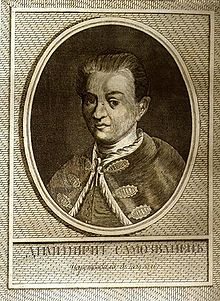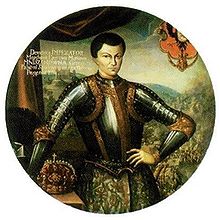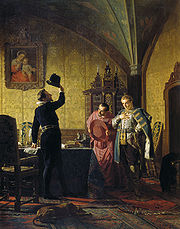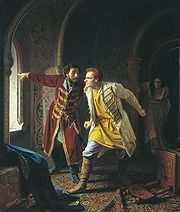- False Dmitriy I
-
Dmitriy II the False Tsar of All Russia 
Reign 21 July 1605 – 17 May 1606 Coronation 21 July 1605 Predecessor Feodor II of Russia Successor Vasili IV of Russia Spouse Marina Mniszech Full name Jurij (Grigorij) Otriepjew Father Unknown Mother Unknown Born 1581 Died 17 May 1606 Signature 
False Dmitriy I (Cyrillic Лжедмитрий; other transliterations: Dimitri, Dimitrii, Dimitriy, Dimitry, Dmitri, Dmitrii, Dmitry) was the Tsar of Russia from 21 July 1605 until his death on 17 May 1606 under the name of Dimitriy Ioannovich (Cyrillic Димитрий Иоаннович). He is sometimes referred to under the usurped title of Dmitriy II. He was one of three impostors who claimed during the Time of Troubles to be the youngest son of Ivan the Terrible, tsarevitch Dmitriy Ivanovich, who had supposedly escaped a 1591 assassination attempt. It is generally believed that the real Dmitriy was assassinated in Uglich and that this False Dmitriy's real name was Grigory Otrepyev, although this is far from certain.
Contents
Background
False Dmitriy I appeared in history circa 1600, when he made an impression on Patriarch Job of Moscow with his learning and assurance. Tsar Boris Godunov, however, ordered him to be seized and examined, whereupon he fled to Prince Constantine Ostrogsky at Ostroh, then in the Polish-Lithuanian Commonwealth, and subsequently entered the service of another Ruthenian family, the Wisniowieckis. Princes Adam and Michał Wiśniowiecki found his story to be convincing, as to who he purported to be, and it gave them an opportunity to get involved in the political turmoil that was transpiring in Muscovy.
There were vague rumours that Dmitriy was an illegitimate son of the Polish king, Stefan Batory, who had reigned from 1575 to 1586. According to a later tale, Dmitriy blurted out his identity when his master had slapped him in anger. Dmitriy himself claimed that his mother, the widow of Tsar Ivan, had anticipated Boris Godunov's assassination attempt and had given him into the care of a doctor who hid with him in Russian monasteries. After the doctor died, he had fled to Poland where he worked as a teacher for a brief time before coming to the service of Wisniowiecki. A number of people who had known Tsar Ivan later claimed that Dmitriy did resemble the young tsarevitch. Dmitriy displayed aristocratic skills like riding and literacy and spoke both Russian and Polish.
Regardless of whether they believed the tale of Dmitriy, Adam Wiśniowiecki, Roman Różyński, Jan Sapieha and several other Polish noblemen decided to support him against Tsar Boris Godunov. In March 1604, Dmitriy visited the royal court of Sigismund III Vasa in Kraków. The king provisionally supported him, but did not promise any direct aid to help him on his way to the throne of Russia. To attract the support of powerful Jesuits, Dmitriy publicly converted to Roman Catholicism on 17 April 1604 and convinced the papal nuncio Claudio Rangoni to back up his claim. At that time he also met Marina Mniszech, a Polish noblewoman, who was a daughter of Jerzy Mniszech. He asked for her hand and was promised it in return for giving to the Mniszech family the Russian towns of Pskov, Novgorod, Smolensk and Novhorod-Siverskyi.
Way to the Russian throne
When the Tsar Boris heard about the pretender, he claimed that the man was just a runaway monk called Grigory Otrepyev (born Yury Otrepyev; Grigory was the name given at the monastery), although on what information he based this claim is unclear. Regardless, his support began to wane, especially when he tried to spread counter-rumors. Some of the Russian boyars also claimed to accept Dmitriy's claim because it gave them legitimate reason not to pay taxes to Boris.
Dmitriy attracted a number of followers, formed a small army, and gained the support of Commonwealth magnates who gave him approximately 3500 soldiers from their private armies. With them he rode to Russia on June 1604. Enemies of Boris, including the southern Cossacks, joined his forces on his way to Moscow. Dmitriy's forces fought two engagements with reluctant Russian soldiers; they won the first, capturing Chernigov (modern Chernihiv), Putivl (Putyvl), Sevsk, and Kursk but badly lost the second and nearly disintegrated. Dmitriy's cause was only saved when the news of the sudden death of Tsar Boris (13 April 1605) reached the troops.
This removed the last barrier to the pretender's further progress. Russian troops began to defect to Dmitriy's side, and on 1 June boyars in Moscow imprisoned the newly-crowned tsar, Feodor II, and his mother and later killed them. On 20 June Dmitriy made his triumphal entry into Moscow, and on 21 July he was crowned tsar by a new patriarch of his own choosing, the Greek Ignatius.
False Dmitriy's policies as a tsar
At first the new tsar tried to consolidate his power by visiting the sepulchre of Tsar Ivan and the convent of his widow Maria Nagaya, who accepted him as her son. The Godunov family was executed with the exception of Princess Xenia Godunova, whom he raped and imprisoned as his concubine. In contrast, many of the noble families exiled by Godunov - such as the Shuiskys, Golitsins and Romanovs - were granted his grace and allowed to return back to Moscow. Filaret (Feodor Romanov) he appointed as metropolitan of Rostov. Patriarch Job of Moscow, who did not recognize him as the new tsar, was sent to exile.
Dmitriy planned to introduce a series of political and economical reforms. He restored Yuri's Day, the day when serfs were allowed to move to another lord, to ease the conditions of peasantry.
In foreign policies, Dmitriy sought for an alliance with the Polish-Lithuanian Commonwealth and Roman Pope. He planned a war against the Ottoman Empire and ordered the mass production of firearms. In his correspondence he referred to himself as "Emperor of Russia", a century before Peter I, though this title wasn't recognized at the time.
On 8 May 1606, Dmitriy married Marina Mniszech in Moscow. Usually when a Russian Tsar married a woman of another faith, she first converted to Orthodox Christianity. It is believed that Dmitriy had made a concession to his Polish supporters to convert Russia to Catholicism after gaining the throne. For this reason, Marina did not convert to the Orthodox faith.
This angered the Russian Orthodox Church, the boyars, and the population alike and increased the support of his enemies. The boyars, headed by Prince Vasily Shuisky, began to plot against him, accusing him of spreading Roman Catholicism and sodomy. They gained popular support, especially as Dmitriy was guarded by Commonwealth forces, who still garrisoned Moscow and often engaged in various criminal acts and angered the local population.
On the morning of 17 May 1606, about two weeks after the marriage, conspirators stormed the Kremlin. Dmitriy tried to flee through a window but broke his leg in the fall. One of the plotters shot him dead on the spot. The body was put on display and then cremated, the ashes reportedly shot from a cannon towards Poland. Dmitriy's reign had lasted a mere ten months. Vasili Shuisky took his place as Tsar Vasili IV.
However, two further impostors later appeared, False Dmitriy II and False Dmitriy III.
Portrayals in literature
- The False Dmitriy's story was dramatized by Schiller (in Demetrius), Sumarokov, Pushkin, Khomyakov, by Modest Mussorgsky in the opera Boris Godunov and by Antonín Dvořák in his opera Dimitrij. In the Pushkin tragedy and the Mussorgsky opera, Otrepyev is a young monk who decides to impersonate the Tsaravitch when he hears they would have been the same age had the child lived.
- Rainer Maria Rilke recounts the overthrow of the False Dimitriy in The Notebooks of Malte Laurids Brigge, Rilke's only longer prose work.
- Harold Lamb fictionalizes the demise of the False Dimitriy in "The Wolf Master", in which the claimant survives his assassination through trickery, and flees East, pursued by a Cossack he has betrayed.
See also
- Ivan Bolotnikov
- Isaac Massa
- Polish-Muscovite War (1605-1618)
- Tsars of Russia family tree
External links
Regnal titles Preceded by
Feodor IITsar of Russia
1605–1606Succeeded by
Vasili IVCategories:- 1581 births
- 1606 deaths
- 1606 crimes
- Converts to Roman Catholicism from Eastern Orthodoxy
- Deaths by firearm in Russia
- History of Russia
- Impostor pretenders
- Leaders ousted by a coup
- Leaders who took power by coup
- Murdered Russian monarchs
- Orthodox monarchs
- Politics of Muscovy
- Pretenders to the Russian throne
- Russian Roman Catholics
- Russian tsars
- Russian rapists
Wikimedia Foundation. 2010.






